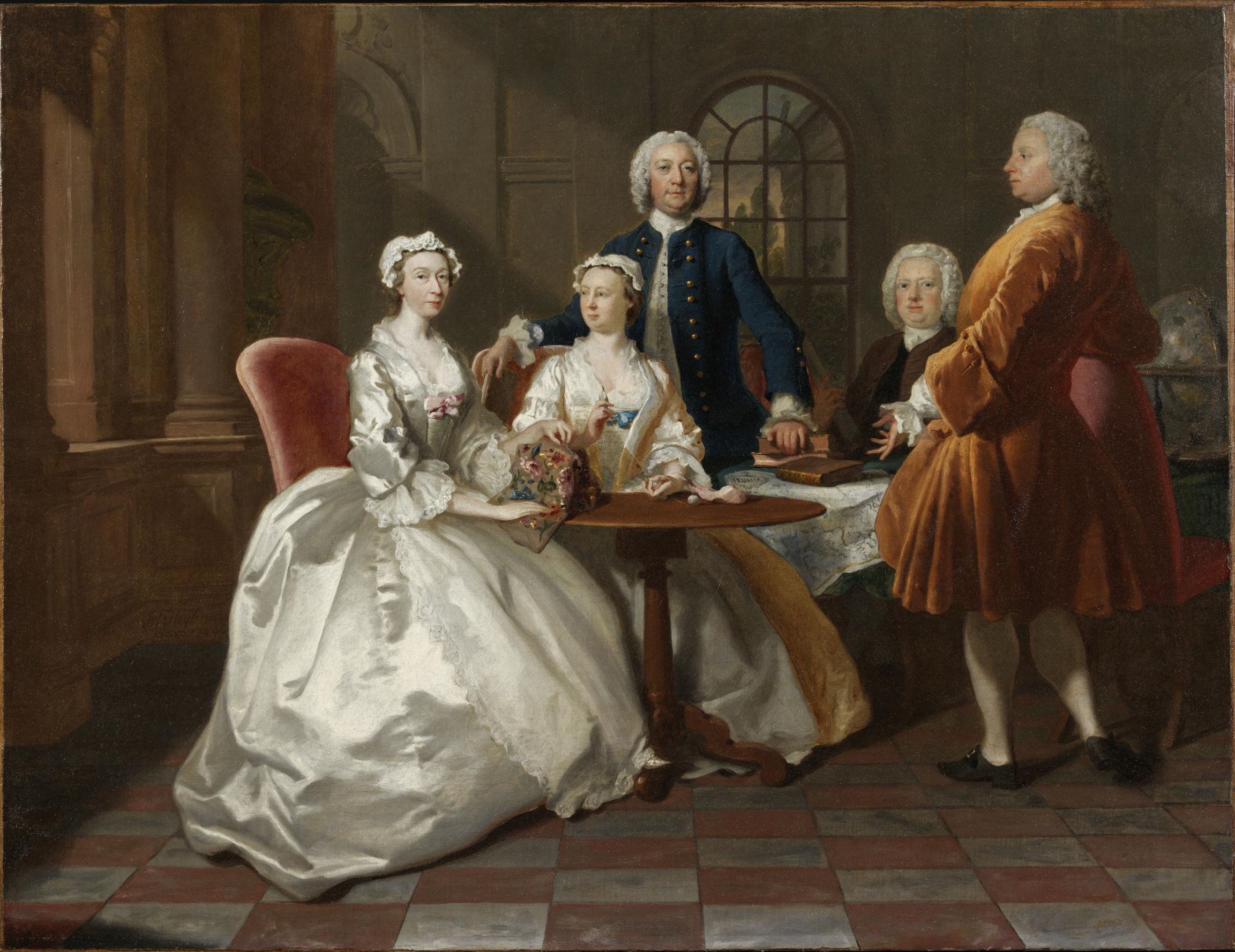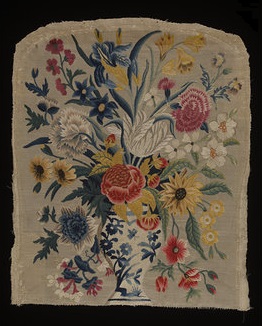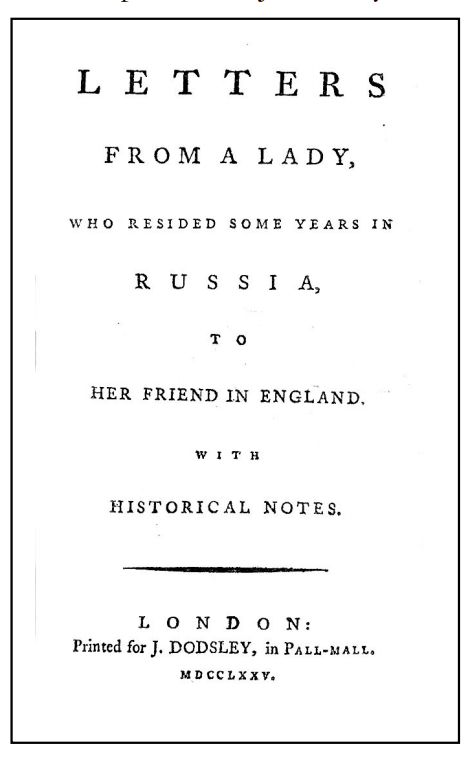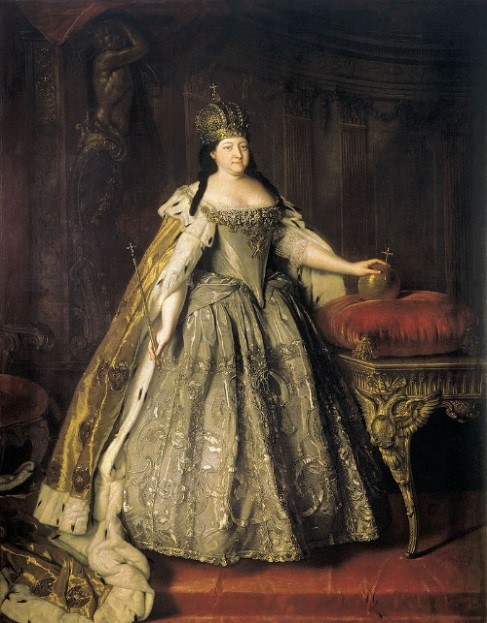The remarkable story of an 18th-century girl from Graffham
 Jane Vigor was born in Graffham in 1699, the daughter of Revd. George Goodwin, the parish priest. She inherited a substantial fortune, outlived three husbands and became a celebrated correspondent from the court of Empress Anna of Russia.
Jane Vigor was born in Graffham in 1699, the daughter of Revd. George Goodwin, the parish priest. She inherited a substantial fortune, outlived three husbands and became a celebrated correspondent from the court of Empress Anna of Russia.
Early life
Jane was baptised at Graffham parish church on 20 February 1699, the daughter of the Reverend George Goodwin M.A. and his wife, Elizabeth, née Styles.Note 1 Jane grew up in Graffham with her older brother Richard until the family left the village in early 1709, when Jane was ten years old. The family then settled in the West Yorkshire village of Methley, about seven miles south-east of Leeds, where George Goodwin was to remain as parson for the next 40 years.
On 20 November 1718, Jane Goodwin (aged 19) married Thomas Ward at Temple Church in the City of London.Note 2 Thomas was the son of Sir Edward Ward, the former chief baron of the exchequer, and Elizabeth Papillon. Sir Edward Ward is best known as the judge in the state trial of the pirate, Captain Kidd, in 1701.
Jane’s brother, Richard, died in the 1720s following which she inherited his estate. According to the Yorkshire diarist, John Hobson (writing in 1726), ‘Mr. Goodwin, minister of Methley, … lost 40,000/- in the South Sea, and married his daughter to a Russian merchant, and had given her 14,000/- to her portion’.
Marriage to Claude Rondeau
In May 1728, Thomas Ward was appointed to the post of consul-general to Russia. Jane accompanied her husband to St Petersburg, arriving in August, together with his secretary, Claude Rondeau. Jane wrote of her sadness in leaving ‘a fond father, from whose presence I had never been a fortnight in my whole life till I left him to come into a strange country’.
Ward died suddenly on 4 February 1731,Note 3 following which Rondeau quickly took over, not only his commission, but also his widow, as on 23 November, Jane married Rondeau at St Petersburg.
Rondeau, the son of a French protestant who had settled in England, was a success in his new role serving the British government effectively, helping to reconcile the bickering factions within the Russian Company at St Petersburg. In the meantime, Jane took an active role in the Russian social scene, becoming a favourite of Empress Anna and attending various court parties, weddings etc.
Several sources state that Jane lost a child in infancy, probably in 1737. In a letter to William Stanhope, 1st Earl of Harrington in June 1737, Rondeau wrote: “My wife, having been for a long time in an ill state of health … she went from hence … by shipping in order to consult the doctors of London”. In letter 27 of her “Letters from a Lady…”, dated Petersburgh 1737, she writes about an ice slide that was constructed at the royal palace, which members of the court took turns to descend on sledges.
I was terrified out of my wits, for fear of being obliged to go down this shocking place, for I had not only the dread of breaking my neck, but of being exposed to indecency too frightful to think on without horror, and I stayed away from some time almost with the hopes that somebody would break a limb, and put a stop to it; but at last I was forced to appear… but her Majesty said my ‘present condition made it improper’, and so I was excused.
Rondeau was described as a ‘delicate’ man and died, probably from the effects of a cold, on 5 October 1739. Jane was again expecting a child and decided to return to England.
Return to England and an amazing coincidence
In January 1740, Jane set off with a letter from the Empress addressed to King George II, requesting his ‘consideration in the melancholy situation she is in’. The letter continued: ‘We likewise having a particular benevolence towards the said Widow for her good deserts, and consequently taking a share in her Welfare, are desirous on our side any way, to promote it.’
Rather than travel by sea, it was decided that Jane should travel overland and the journey through the snows of Russia was undertaken by sledge; she was accompanied on her journey by William Vigor, a Quaker merchant, who was also returning to England. (Vigor was the St Petersburg agent of the Bristol-based iron and steel importers, Graffin Prankard and Caleb Dickinson.)
They travelled over 550 miles through the region of Livonia and the Duchy of Courland (now part of Latvia) before reaching the port of Memel (now the Lithuanian city of Klaipeda) on the Baltic Sea. At this time, Memel was in Polish Prussia and the port was full of Prussian troops. The party spent their first night in the only accommodation that they could find, an inn crowded with noisy soldiers and officers.
On the afternoon after their arrival, Vigor went into the town to visit merchants and other prominent citizens. In conversation with a Mr Meyer, Vigor explained their problems and enquired if Meyer knew of any accommodation more suitable for a lady in Jane’s condition. Meyer replied that he knew of some apartments that were available, which he described as ‘commodious’. While Vigor continued with his business meetings, Meyer sent a note to Jane in which he offered the apartments, hoping that she would ‘find every accommodation that she could desire’ adding that ‘the sooner she came, the better’. Immediately, Jane’s servants were ordered to get everything ready and, as soon as a coach could be procured, they set out for the apartments.
On reaching the apartments, Jane found them to be spacious and stately and they were treated to everything they could require. After supper, they discovered that the apartments were actually the home of Mr Meyer, who was out for the evening. The following morning, they were greeted at breakfast by Meyer and his son.
Jane thanked Meyer for his kindness, but at the same time told him how much she was embarrassed, as she was unable to offer anything in return. Meyer begged Jane and her friends not to worry on that account, adding ‘All I do is return it as a consequence of favours received, so that your debt is cancelled before it is incurred’.
As they did not understand what he meant, he continued: ‘You must know that I have a great esteem for the English nation in general, but I have obligations which enhance my regard. You see here this young man who is my son; he was last year upon his travels in England. Passing down from the north to the capital, he was taken very ill. His disorder was so violent that he was forced to take refuge wherever he could find shelter, which was not easy to be procured. His distemper was the smallpox, and he was housed in a small, dirty ale-house, where he must have died for want of care and accommodation.’
‘A gentleman of the place heard that a stranger was ill, and was so humane as to make him a visit. When he found the nature of his disorder, he ordered him to be wrapped securely, and conveyed him in his coach to his own house. To this gentleman’s goodness, and to the assiduity and attention of those about him, my son owes his life, and I am indebted for my son. Hence I make it my rule that no person from England shall come to this place without meeting from me every mark of regard that I can possibly show.’
‘Pray sir,’ Jane asked the son, ‘whereabouts was it in the north of England that you met with this civility.’
‘It was,’ he replied, ‘at a place called Methley, near Leeds in Yorkshire.’
Struck by this, Jane continued, ‘And pray sir, may I ask what was the gentleman’s name?’
‘His name, madame, ‘ came the reply, ‘was Goodwin’.
‘Sir.’ said Jane, ‘It was my own father!’
After recovering from the initial shock of such a strange coincidence, Meyer’s son commented that he ought to have known her at once, ‘for no daughter can be more like a father than you are to Mr Goodwin.’
The following day, Meyer sent for his daughter to keep Jane company. The two ladies soon became friends and the daughter invited Jane to remain with the family until after her confinement. Jane, however, was anxious to return home and, after a few days ‘she was obliged to leave this grateful and hospitable family’.
Together with William Vigor, Jane resumed her journey, travelling through Königsberg and Danzig (now Gdansk) to Hanover, where they spent a few days, before travelling on to the port of Helvoit (now Hellevoetsluis) in Holland, from where they were able to obtain a passage to England.
Later life
 On 8 May 1740, Jane’s daughter, Claudia was born. Sadly she died three weeks later and was buried at St Dunstan’s Church, Canterbury. Subsequently, the body of Claudius was repatriated and buried alongside his daughter. Several other members of Claudius’s family, including his parents, are also interred at St Dunstan’s. Jane had a memorial plaque erected inside St Dunstan’s bearing the inscription:
On 8 May 1740, Jane’s daughter, Claudia was born. Sadly she died three weeks later and was buried at St Dunstan’s Church, Canterbury. Subsequently, the body of Claudius was repatriated and buried alongside his daughter. Several other members of Claudius’s family, including his parents, are also interred at St Dunstan’s. Jane had a memorial plaque erected inside St Dunstan’s bearing the inscription:
‘Near this place lies interred the body of Claudius Rondeau Esq., His Majesty’s resident at the Court of Russia from the year 1730 to the year 1739. He was born March 20th 1695 and died at St. Petersburg October 5th 1739. This monument was erected to his memory by his widow Jane, the daughter of the Revd. Mr. Goodwin and relict of Thomas Ward Esq., son to the late Lord Chief Baron Ward. Here also lies interred the body of his posthumous daughter Claudia Rondeau born May 8th 1740, died the 31st of the same month.’
Jane and William Vigor were married in the Chapel at Somerset House (in the parish of St Mary le Strand) in Westminster on 4 May 1743. The priest who officiated at the wedding was the Revd. Thomas Newcomb who was rector at both Stopham and at Barlavington (three miles east of Jane’s birthplace), and previously a curate at Petworth.
Jane and her third husband seem to have settled into a life of genteel obscurity, although William occasionally represented Prankard and Dickinson’s interests in London. After a few years in London, in 1749 the couple settled at Taplow House, in Berry Hill, near Maidenhead. Described as ‘a substantial property with stables, garden, orchards, and several acres of arable land and meadow’, Taplow House was situated in an area popular with many Quaker families, including William Penn, founder of Pennsylvania, who is buried at Jordans Friends’ Meeting House, about an hour’s ride away.
William Vigor died at Taplow on 11 October 1767 and was buried in the churchyard at St Nicholas, Taplow. Jane later moved out of Taplow House to nearby Windsor, where she died on 6 September 1783. She was buried alongside William in Taplow churchyard. Her will opens:
This is the Last Will and Testament of me Jane Vigor of New Windsor … Widow. First I desire I may be buried in a leaden Coffin in the Vault where my late dear Husband lies in the Church Yard of Taplow in as private a manner as possible, no Pall Bearers only two Horses to the Hearse unless the Coffin should be too heavy, and then four only with Smith and the Child to attend it …’ (‘My Servant Ann Smith’ is mentioned several times.)
Among her possessions was a ‘picture of my Father Goodwin that hangs over the Chimney in the Drawing Room of my House at Taplow now let…’
Her obituary by John Nichols in the Gentleman’s Magazine described Jane as having ‘lived much in the world, and being well acquainted with books, her conversation was the delight of all who had the pleasure of knowing her’ and that her loss was ‘severely felt by the neighbouring poor, amongst whom she was constantly searching after proper objects for the exertion of her charity and benevolence’.
Another English resident of St Petersburg described Jane as ‘a fine woman; very tall, and perfectly genteel’, and ‘in all her answers, even to her inferiors, she shows the greatest condescension, and most obliging temper’.
 In 2009, the Victoria & Albert Museum in London accepted a group of 22 sofa and chair covers embroidered by Jane Vigor, together with a ‘conversation piece’ by Joseph Highmore (1692–1780), in lieu of an Inheritance Tax liability. The painting (above) shows Jane (on the left) and her sister-in-law, Ann, and their husbands, William Vigor and his elder brother Joseph (both standing). The third man (seated) in the painting is probably John Penn (1700–1746), son of the founder of Pennsylvania, with whom the Vigors were close friends.
In 2009, the Victoria & Albert Museum in London accepted a group of 22 sofa and chair covers embroidered by Jane Vigor, together with a ‘conversation piece’ by Joseph Highmore (1692–1780), in lieu of an Inheritance Tax liability. The painting (above) shows Jane (on the left) and her sister-in-law, Ann, and their husbands, William Vigor and his elder brother Joseph (both standing). The third man (seated) in the painting is probably John Penn (1700–1746), son of the founder of Pennsylvania, with whom the Vigors were close friends.
 In the picture, Jane is holding an example of her embroidery, while Ann is knotting silk thread with a shuttle.
In the picture, Jane is holding an example of her embroidery, while Ann is knotting silk thread with a shuttle.
The group of seat covers held by the V & A are embroidered on an unusual worsted ground and it is possible that they were worked by Jane while she was in St Petersburg, adapting Russian materials to her English design and needle skills.
Her letters make several references to her working at embroidery, as an English practice that caught the attention of the Russian Empress Anna, and undertaking projects of an extensive scale.
The cover in the picture has a design of a wide variety of flowers in a blue and white Chinese-style vase.
“Letters from a Lady…”
During her eleven years in St Petersburg, Jane wrote regularly to her friends and family in England. In 1775, a selection of her letters was published under the title Letters from a Lady, who resided some years in Russia, to her Friend in England. With historical notes. In the Gentleman’s Magazine, John Nichols states that ‘she was in a manner obliged to publish, to prevent a spurious and incorrect copy from being obtruded on the world’.
 Despite the absence of the author’s name, contemporaries soon found out that the anonymous letters had been written by Mrs Vigor. As most of the 37 letters had been written during the time she was married to Claudius Rondeau, the letters were generally referred to as ‘Lady Rondeau’s Letters‘. (The incorrect appellation ‘Lady’ presumably came about because of the use of the word in the full title of the publication, although Jane was plain ‘Mrs’.)
Despite the absence of the author’s name, contemporaries soon found out that the anonymous letters had been written by Mrs Vigor. As most of the 37 letters had been written during the time she was married to Claudius Rondeau, the letters were generally referred to as ‘Lady Rondeau’s Letters‘. (The incorrect appellation ‘Lady’ presumably came about because of the use of the word in the full title of the publication, although Jane was plain ‘Mrs’.)
The letters were favourably received and were translated into German, French and Dutch by 1776, with a second English edition being published in 1777. In 1836, the letters were translated into Russian; this edition was considered unsatisfactory, being heavily censored, and a completely revised edition was published in 1874 by Eugene Karnovich. Jane’s letters were highly valued by historians as a source depicting Russian society during a period of transition in the mid-18th century.
In 1784, after Jane’s death the previous year, some more letters were found among her papers; these were published under the title Eleven additional letters from Russia, in the reign of Peter II. By the late Mrs. Vigor. Never before published. The preface states that these letters were ‘found among her papers since her decease’ and include a short biographical preface and some historical notes. These letters precede the originals chronologically and cover her earliest years at St Petersburg, and were more personally revealing than those she had published during her lifetime.
Jane’s letters offer a unique eyewitness account of life at the court at St Petersburg and amongst the expatriate community; contemporary reviewers praised the anecdotes of courtly occasions, including marriages, coronations and funerals, as well as stories of aristocratic intrigue and romance.

Of Princess (later Empress) Anna, Jane wrote: ‘she is neither handsome nor genteel, and her mind has not yet displayed very shining qualities. She is very grave, seldom speaks, and never laughs; which to me is very unnatural in one so young, and, I think, her gravity rather proceeds from stupidity than judgement.’ She later describes the Empress as ‘a large woman, towering above the tallest cavaliers of her court, but very well shaped for her size, easy and graceful in her person, and of a majestic bearing. She had an awfulness in her countenance that struck one at first sight, and indeed revolted those who disliked her.’
In 1739, Jane attended the wedding of Anna Leopoldovna, the daughter of Catherine, the sister of the Empress Anna, to Anton Ulrich, Duke of Brunswick. (The marriage was intended to strengthen the relationships between the houses of Romanov and Habsburg.) Afterwards she wrote, ‘And thus ended this grand wedding, from which I am not yet rested, and what is worse, all this rout has been made to tie two people together who, I believe, heartily hate one another; at least, I think, she showed it throughout all this week’s feasting in a shocking public manner, and continues to treat him with the utmost contempt when out of the empress’s sight.’ Of Anton, she wrote ‘I could not help thinking he looked like a victim’. (This casual phrase was to turn into a prophecy when the couple and their son, Ivan, were imprisoned in 1741 by the new Empress Elizabeth.)
Notes
1. The biography in the Oxford Dictionary of National Biography incorrectly claims that Jane was the daughter of the Revd Edward Goodwin of Rawmarsh Hall, Yorkshire, and Jane Wainwright. This claim is repeated in several other sources.
2. The preface to Eleven additional letters from Russia published in 1784, the year after Jane’s death, includes some biographical notes, which state incorrectly that she was married ‘to Thomas Ward, Esq. Consul General to Russia, 1728’. This assertion that Jane married Ward in 1728 is repeated in every subsequent article about Jane. ‘England, Marriages, 1538–1973’ (published in 2013), however, includes a record of Jane Goodwin marrying Thomas Ward at Temple Church on 20 November 1718.
3. Prior to 1752, the civil or legal year in England began on 25 March (Lady Day). As a consequence, the death of Thomas Ward was recorded in contemporary records as being in February 1730 (i.e. 1730/31) whereas the modern equivalent is February 1731.
Sources
Ancestry.co.uk
England & Wales, Non-Conformist and Non-Parochial Registers, 1567-1970
England & Wales, Prerogative Court of Canterbury Wills, 1384-1858
England, Select Births and Christenings, 1538-1975
England, Select Marriages, 1538–1973
The Clergy Database: Newcomb, Thomas (1704 – 1765)
Cross, Anthony (27 Apr 2014): In the Land of the Romanovs: An Annotated Bibliography of First-hand English-language Accounts of the Russian Empire (1613-1917) Open Book Publishers
Delany, Mary & Woolsey, Sarah Chauncey (Ed.) The autobiography and correspondence of Mrs. Delany. Volume 1 (Boston, 1879) pp. 209–212
Historic Canterbury: Memorials in St. Dunstan’s Church
Kent Archaeological Society:
Claude Rondeau 1703. St Dunstan’s Church, Canterbury
St Dunstan’s Church, Canterbury
Leeds Royal Bazaar Gazette (28 May 1868) A Good Deed – Strangely recorded
Loewenson, Leo (June 1957) Lady Rondeau’s Letters from Russia (1728 – 1739) ‘The Slavonic and East European Review’. Vol. 35, No. 85. pp. 399–408
Thackray, Bill (27 June 2017): The Remarkable Life of Jane Vigor. Methley Village History
Turner, Katherine (3 January 2008): Vigor [other married names Ward, Rondeau], Jane. Oxford Dictionary of National Biography
University of Wolverhampton: British Travel Writers. (22 May 2016) Jane Vigor (Author)
Victoria and Albert Museum: A group of 18th-century embroidered sofa and chair covers and a related conversation piece by Joseph Highmore.
Vigor, Mrs William (Revised 1777) Letters from a lady, who resided some years in Russia… Google Books Internet Archive (read online)
Vigor, Mrs (1775) Letters From a Lady, who Resided Some Years in Russia, to her Friend in England. With Historical Notes. Amazon Books
Vigor, Mrs (1785) Eleven additional letters from Russia, in the reign of Peter II. Amazon Books
Warren, Bob (December 2013) Jane Vigor: An Eighteenth Century English Gentlewoman Abroad Friends of Somerset Archives
Photograph credits
Portrait: Cropped from A portrait of the Vigor Family. Highmore, Joseph (Victoria & Albert Museum)
Rondeau Memorial: Claudius Rondeau (St Dunstan Churchyard). Find a Grave
Book cover: Letters From A Lady, Who Resided Some Years In Russia, 1775 (Third Floor Rare Books)
Empress Anna: Portrait of Empress Anna Ioannovna. Caravaque, Louis (Wikipedia Commons)
Family portrait: A portrait of the Vigor Family. Highmore, Joseph (Victoria & Albert Museum)
Chair seat cover: Chair seat cover: Vigor, Jane